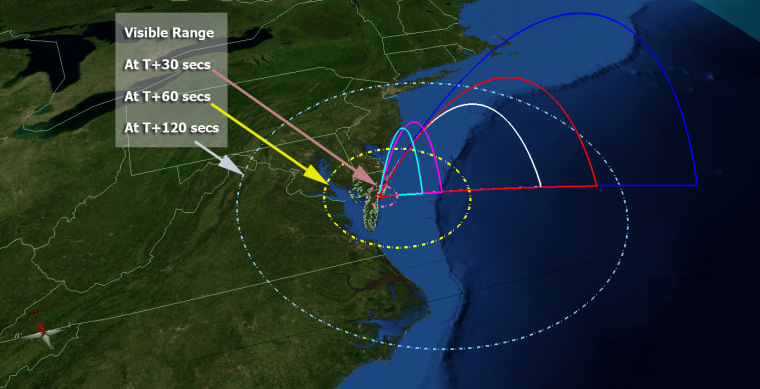NASA is once again hoping to launch five rockets in just over five minutes this week — a space barrage that promises to put on a spectacular midnight light show of luminescent vapor trails above the U.S. East Coast to probe mysterious, fast-moving winds at the edge of space — but only if Mother Nature cooperates.
After a series of delays due to bad weather and a technical glitch, NASA is aiming to launch the five-rocket barrage as early as late Tuesday night from its Wallops Flight Facility in Virginia. The launch forms the core of the agency's Anomalous Transport Rocket Experiment, or ATREX. The unmanned rockets will release chemical tracers at about 60 miles (97 kilometers) up, allowing scientists to track high-altitude winds that can top 300 mph (483 kph).
These tracers will generate luminous milky-white clouds that should be visible to folks on the ground from parts of South Carolina up through southern New England, researchers have said.
If all goes well, NASA intends to photograph the trails from three different sites: Wallops Island, Tuckerton, N.J., and Duck, N.C. Should weather conditions be unfavorable, the firings will be delayed to another night, with alternate launch dates available through April 3.
The rockets were originally slated to launch on March 14, but radio frequency interference on one of the rockets prevented the liftoff. Each night since then, the launch has been postponed because of unfavorable weather conditions at the three viewing sites. Clear skies are required at all three sites to allow for a launch. Weather conditions will be accessed each afternoon and a decision to launch will be made by evening.
The $4 million ATREX mission aims to study the high-altitude jet stream, which whistles along 60 to 65 miles (97 to 105 km) above Earth's surface — much higher up than the jet stream commonly referred to in weather forecasts, which is found at an altitude of just 6 miles (10 km) or so.
And it's much stronger than the lower jet stream, too, with winds routinely reaching 200 mph and occasionally topping 300 mph. Theory suggests that the high-altitude jet stream should blow at only about 50 mph (80 kph), researchers have said. Scientists hope ATREX helps them understand why the actual winds are so much faster.
ATREX's five sounding rockets will launch over the Atlantic Ocean within a span of five minutes and 20 seconds. While the rockets' trajectories are different, they'll all release their tracer — a chemical called trimethyl aluminum — roughly simultaneously. Two of the rockets will also carry instruments that measure temperature and atmospheric pressure.
Three different cameras — one at Wallops and one each in New Jersey and North Carolina — will track the tracer clouds, measuring how quickly they move away from each other.
The launch must occur at night under clear skies, to make sure the cameras have a clear view of the glowing tracer clouds. That means many skywatchers along the East Coast should get a good look, too.
The ATREX launch window extends through April 3, opening no earlier than 11 p.m. EST each night and closing no later than 6:30 a.m. EST the following morning, NASA officials have said.
NASA will broadcast the five ATREX launches online live, with coverage beginning two hours before the opening of the launch window. The webcast will be available here.
The rockets being used for the mission are two Terrier-Improved Malemutes, two Terrier-Improved Orions and one Terrier-Oriole. All will fall harmlessly into the Atlantic after they release the trimethyl aluminum. The chemical poses no threat to the environment or human health, researchers said.
Follow Space.com for the latest in space science and exploration news on Twitter @Spacedotcom and on .
